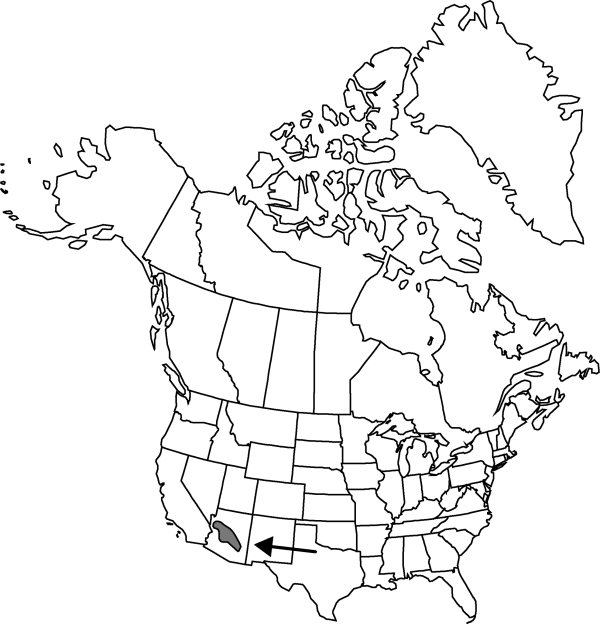familyCactaceae
subfamilyCactaceae subfam. Opuntioideae
genusCylindropuntia
speciesCylindropuntia acanthocarpa
Difference between revisions of "Cylindropuntia acanthocarpa var. thornberi"
Cactaceae 1: 184. 1958.
Common names: Thornber cholla
Basionym: Opuntia thornberi Thornber & Bonker
Synonyms: Opuntia acanthocarpa var. thornberi (Thornber & Bonker) L. D. Benson
FNA>Volume Importer |
FNA>Volume Importer |
||
| Line 23: | Line 23: | ||
}}<!-- | }}<!-- | ||
| − | --><span class="statement" id="st- | + | --><span class="statement" id="st-undefined" data-properties=""><b>Shrubs,</b> with few to many branches, at acute and obtuse angles. <b>Stem</b> segments gray-green, 10–25(–50) cm; tubercles very prominent and broad, 2.5–4.5 cm. <b>Spines</b> 6–11(–14) per areole, rarely interlacing with spines of adjacent areoles, yellow to deep red-brown, aging gray, not baggy sheathed; major abaxial spines usually deflexed and spreading. <b>Flowers</b>: inner tepals yellow to bronze. <b>Fruits</b> bearing few spines, sometimes spineless; areoles 12–20. <b>2n</b> = 22.</span><!-- |
-->{{Treatment/Body | -->{{Treatment/Body | ||
| + | |phenology=Flowering mid-late spring (Apr–Jun). | ||
|habitat=Sonoran and Mojave deserts, desert grasslands, chaparral transition areas, rocky hills, ridges | |habitat=Sonoran and Mojave deserts, desert grasslands, chaparral transition areas, rocky hills, ridges | ||
|elevation=600-1500 m | |elevation=600-1500 m | ||
| Line 44: | Line 45: | ||
|basionyms=Opuntia thornberi | |basionyms=Opuntia thornberi | ||
|family=Cactaceae | |family=Cactaceae | ||
| + | |phenology=Flowering mid-late spring (Apr–Jun). | ||
|habitat=Sonoran and Mojave deserts, desert grasslands, chaparral transition areas, rocky hills, ridges | |habitat=Sonoran and Mojave deserts, desert grasslands, chaparral transition areas, rocky hills, ridges | ||
|elevation=600-1500 m | |elevation=600-1500 m | ||
| Line 51: | Line 53: | ||
|publication year=1958 | |publication year=1958 | ||
|special status= | |special status= | ||
| − | |source xml=https://jpend@bitbucket.org/aafc-mbb/fna- | + | |source xml=https://jpend@bitbucket.org/aafc-mbb/fna-data-curation.git/src/9216fc802291cd3df363fd52122300479582ede7/coarse_grained_fna_xml/V4/V4_224.xml |
|subfamily=Cactaceae subfam. Opuntioideae | |subfamily=Cactaceae subfam. Opuntioideae | ||
|genus=Cylindropuntia | |genus=Cylindropuntia | ||
|species=Cylindropuntia acanthocarpa | |species=Cylindropuntia acanthocarpa | ||
|variety=Cylindropuntia acanthocarpa var. thornberi | |variety=Cylindropuntia acanthocarpa var. thornberi | ||
| − | |||
| − | |||
| − | |||
| − | |||
| − | |||
| − | |||
| − | |||
| − | |||
| − | |||
| − | |||
| − | |||
| − | |||
| − | |||
| − | |||
| − | |||
| − | |||
| − | |||
| − | |||
| − | |||
| − | |||
| − | |||
}}<!-- | }}<!-- | ||
-->[[Category:Treatment]][[Category:Cylindropuntia acanthocarpa]] | -->[[Category:Treatment]][[Category:Cylindropuntia acanthocarpa]] | ||
Revision as of 14:00, 27 July 2019
Shrubs, with few to many branches, at acute and obtuse angles. Stem segments gray-green, 10–25(–50) cm; tubercles very prominent and broad, 2.5–4.5 cm. Spines 6–11(–14) per areole, rarely interlacing with spines of adjacent areoles, yellow to deep red-brown, aging gray, not baggy sheathed; major abaxial spines usually deflexed and spreading. Flowers: inner tepals yellow to bronze. Fruits bearing few spines, sometimes spineless; areoles 12–20. 2n = 22.
Phenology: Flowering mid-late spring (Apr–Jun).
Habitat: Sonoran and Mojave deserts, desert grasslands, chaparral transition areas, rocky hills, ridges
Elevation: 600-1500 m
Discussion
Selected References
None.
Lower Taxa
None.
